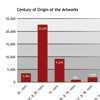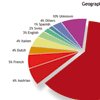Spectrum of the Galerie Heinemann
 Date of origin of the traded artworks
Date of origin of the traded artworks
90 percent of the Galerie Heinemann's trade involved 19th and 20th artworks. 10 percent of the traded artworks were created between the 13th and the 18th centuries. The orientation of the gallery is even more obvious, if you consider only the over 35,000 directly traded artworks or those taken on consignment. Only 3.3 percent of these artworks were created before the 19th century.
The focus on the 19th and 20th century also becomes clear from the approximately 5,000 offers the gallery received. 13th to 18th century works accounted for 40 % of these offers, including a strikingly large number of Baroque artworks, for instance, by Peter Paul Rubens, Rembrandt van Rijn, El Greco, or Renaissance painters such as Titian and Lucas Cranach. Yet precisely these works were not accepted by the gallery. Contemporary 19th and 20th century art remained the specialty of the Galerie Heinemann.
 The important artists in the gallery
The important artists in the gallery
Works by artists from the German-speaking areas (Germany, Austria, and Switzerland) dominated, accounting for over 72 % of the traded goods as well as works on consignment. In contrast, Western and southern European artists accounted for just under 13 percent and Dutch/Flemish artists for just under 3 percent of all items.
A great number of the artworks came from representatives of the so-called Munich School associated with the Munich Academy of Fine Arts, which, particularly in the second half of the 19th century, was one of the leading German painting schools. Its representatives, such as Franz von Defregger, Eduard von Grützner, Franz von Lenbach, Hermann and Friedrich August von Kaulbach, Carl Spitzweg, Josef Wenglein, Heinrich von Zügel and Ludwig von Zumbusch were amongst the artists with the most works sold. Popular motifs included, above all, Bavarian mountain landscapes, the area around Dachau, rural animal depictions, peasant scenes and, not least, portraits. Alongside these, the gallery also traded in well-known depictions by contemporary history painters. Philipp Röth, who today is scarcely known, settled in Munich after his training in Darmstadt and Karlsruhe, and was the artist who sold the most works by far, even surpassing Wilhelm Busch and Franz von Lenbach. His Bavarian landscapes were quite obviously highly desired by the gallery's clients.
Berlin artists, as well, such as Walter Leistikow, Max Liebermann and Lesser Ury found buyers through the Galerie Heinemann. The Düsseldorf Painting School was represented with numerous pictures by Andreas and Oswald Achenbach. The Austrian painters Jakob and Rudolf Alt should also be listed as important contributors to the gallery's portfolio.
Foreign artists whose paintings were traded by the gallery included the French artists François Boucher, Jean-Baptiste Camille Corot, Gustave Courbet, Claude Monet, the Spanish artists Francisco de Goya and Diego Velázquez, as well as the English artists John Constable, George Romney and William Turner.
